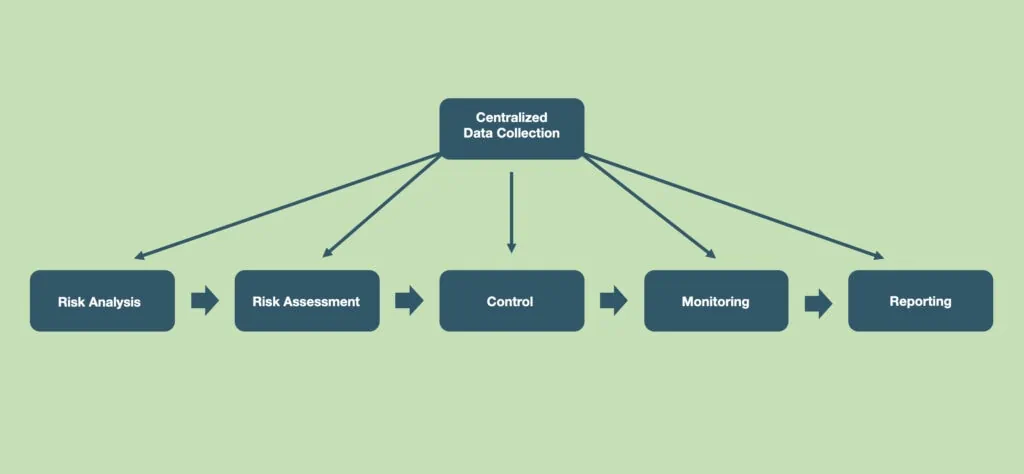

Risk management software is essential for managing a company according to GRC (Governance, Risk & Compliance) principles.
Often silos and outdated document management prevent companies from recording and thus recognizing risks across departments. Opportunities are missed; actions are not taken or are taken too late. Efficient corporate management is therefore difficult to achieve and requires considerable effort.
By using software, risks and opportunities are identified and analyzed. A risk assessment can be carried out as part of risk management tasks by centrally recording all relevant data. This enables management to react quickly to changes and to implement appropriate actions.
What does Risk Management Software do?
Risk management software is an integrated solution for corporate management. The functions of such a software solution make it possible to centrally record, analyze and evaluate risks and opportunities across all areas of the company and enable company management in accordance with compliance guidelines.

Risk-Management-Software-Workflow
Key functions of risk management software in the risk management process.
-
Centralized data collection
Only with centralized data collection and a uniform risk assessment process can risk management software realize its full potential. When this happens, risks are identified, analyzed and assessed in a standardized process.
Data silos are avoided by no longer collecting data locally or in the respective departments and then preparing it for further processing at great expense; instead, everything is collected centrally. This facilitates the updating of data from all integrated company areas.
-
Risk Analysis
Analysis of the collected data makes it possible to incorporate risks and dependencies into the risk assessment.
-
Risk Assessment
By evaluating the analyzed data, the management can efficiently control the company.
-
Control
Prioritization and responsibilities are managed with risk management software through appropriate functions. These can be adjusted at any time. Adherence to compliance rules is significantly simplified.
-
Monitoring
Quality assurance and monitoring of the defined risk management processes are possible in real time.
-
Reporting
Reporting with real-time data makes it possible to assess risks and decide on actions based on current data. It is possible to react quickly to changes.
What is Integrated Risk Management Software?
Ideally, integrated risk management software helps all areas of a company manage risk. It is a platform that supports a wide variety of tasks and functions that are generally assigned to Governance, Risk & Compliance teams. Risk management software is indispensable for integrated risk management, because:
- Risks are assessed and analyzed using standardized processes.
- Standardized processes save resources and simplify data collection, processing and implementation of actions.
- Tasks, roles and activities are defined throughout the company.
- Incorporated compliance rules ensure adherence to regulations and legal requirements.
- Real-time data and reports provide the basis for management to make decisions.
- Opportunities and risks are identified by management at an early stage. As a result, security and innovation activities can be better implemented.
Example Applications of Risk Management Software
In principle, risk management software is useful for identifying and managing risks in all areas of a company. It is the only way to ensure comprehensive risk management within a company.
The following are examples of three important company areas. Below, you will understand the benefits of risk management software in IT, ISM and HR.
Risk Management Software in IT
Particularly in IT, comprehensive and integrated risk management is no longer conceivable without risk management software.
Today, companies are increasingly exposed to risks in the area of IT, to which they must react accordingly. Possible vulnerabilities are detected and eliminated in vulnerability management. Attacks or other events that endanger security and smooth operation in the company are recorded and processed via security incident management.
Damage incurred in IT can quickly jeopardize business operations and even the continued existence of a company. To be able to react as quickly as possible and avoid damage to the company, IT risk management software is essential. Only through appropriate software processes and role assignments can procedures be adhered to and unnecessary work steps or questions about responsibilities avoided. Processes are improved by it and possible errors are worked off.
Revision security is also an important criterion, and in some cases it is legally required in order to enable subsequent audits. This is also possible for IT through the use of risk management software.
Risk Management Software and Information Security Management (ISM)
The retention and security of important and confidential data is defined in ISO/IEC 27002 and must be taken into account by most companies.
Risk management software helps to develop and define rules and procedures in information security management systems (ISMS). The identification, analysis, control and management of possible threats in the company are thus ensured and provide the basis for maintaining the confidentiality, availability and integrity of all information.
Risk Management Software and HR Management
Personnel is one of the most important assets of a company. This makes it all the more important to respond to potential risks at an early stage, to develop strategies and make provisions to mitigate risks:
- Staffing gaps must be identified and a strategy developed to fill the gaps.
- Risks for the failure or loss of management and personnel must be classified accordingly. Plans for ensuring operations, as well as the retention of knowledge, must be developed and implemented.
- The company’s image and employee satisfaction must be monitored.
- Other influences outside the company’s sphere of influence must be taken into account in terms of their impact on HR and their risks assessed accordingly.
Learn how OTRS risk management software solutions can support your company.
Categories
- About OTRS Group (21)
- Automation (3)
- Corporate Security (26)
- Customer Service (30)
- Developing a Corporate Culture (12)
- Digital Transformation (54)
- General (86)
- ITSM (36)
- Leadership (22)
- OTRS in Action (8)
- Processes (5)
- Using OTRS (15)
